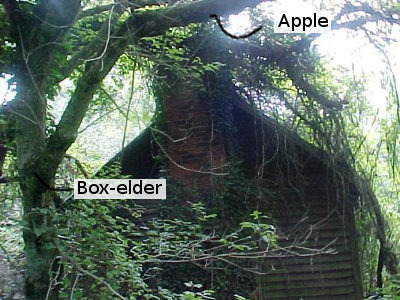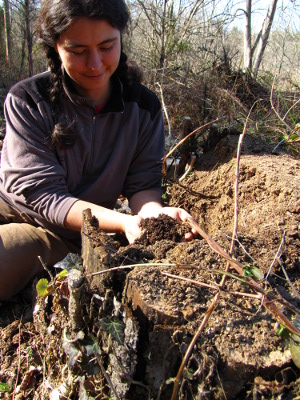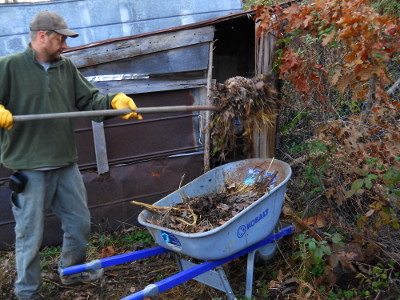
Nurse stump
 The
most recent owners of our farm before us had a standard apple tree
growing right beside their house. I figured that a house apple
was likely to be a delicious local heirloom, but although we really
wanted to keep it, the tree was too old and diseased to save. (If
I'd known as much about trees then as I do now, I would have grafted
some twigs onto new rootstocks to safeguard the variety, but hindsight
is always 20/20.)
The
most recent owners of our farm before us had a standard apple tree
growing right beside their house. I figured that a house apple
was likely to be a delicious local heirloom, but although we really
wanted to keep it, the tree was too old and diseased to save. (If
I'd known as much about trees then as I do now, I would have grafted
some twigs onto new rootstocks to safeguard the variety, but hindsight
is always 20/20.)
 Even
though the apple perished without feeding us a single fruit, its body
has been feeding our garden ever since. The wood was too punky to
burn by the time we cut it up, but the rotting biomass has helped
increase the tilth of our blueberry beds. Last winter, I gathered
stump
dirt out of what
remained of the tree to start seedlings inside, and this fall I've
decided to let the rest of the stump become an instant, high quality
raised bed for my gooseberry
sprout.
Even
though the apple perished without feeding us a single fruit, its body
has been feeding our garden ever since. The wood was too punky to
burn by the time we cut it up, but the rotting biomass has helped
increase the tilth of our blueberry beds. Last winter, I gathered
stump
dirt out of what
remained of the tree to start seedlings inside, and this fall I've
decided to let the rest of the stump become an instant, high quality
raised bed for my gooseberry
sprout.
In many forests, nurse
logs and stumps form natural beds to help along new baby trees, so I'm
just mimicking nature with my action. However, I want nature to
progress a little faster than it would in the wild, so I talked Mark
into cleaning out the deep
bedding in the
broiler coop to add more nitrogen to what is otherwise a low fertility
garden spot.
 While we were at it, we
spread deep bedding on bare patches elsewhere in the blueberry beds,
probably covering about a quarter of the currently mulched area.
All that high nitrogen chicken manure will probably be enough to feed
the blueberries all summer --- the trick will be remembering those
plants got a fall feeding and not topdressing with more compost come
spring. I clearly need some kind of data-collection to go with my
new haphazard
mulching campaign so
everyone gets a fair shake when it comes to feeding.
While we were at it, we
spread deep bedding on bare patches elsewhere in the blueberry beds,
probably covering about a quarter of the currently mulched area.
All that high nitrogen chicken manure will probably be enough to feed
the blueberries all summer --- the trick will be remembering those
plants got a fall feeding and not topdressing with more compost come
spring. I clearly need some kind of data-collection to go with my
new haphazard
mulching campaign so
everyone gets a fair shake when it comes to feeding.
Want more in-depth information? Browse through our books.
Or explore more posts by date or by subject.
About us: Anna Hess and Mark Hamilton spent over a decade living self-sufficiently in the mountains of Virginia before moving north to start over from scratch in the foothills of Ohio. They've experimented with permaculture, no-till gardening, trailersteading, home-based microbusinesses and much more, writing about their adventures in both blogs and books.
Want to be notified when new comments are posted on this page? Click on the RSS button after you add a comment to subscribe to the comment feed, or simply check the box beside "email replies to me" while writing your comment.
- Remove comment
